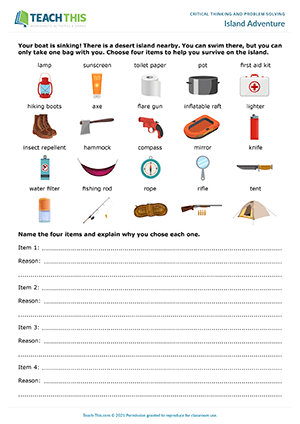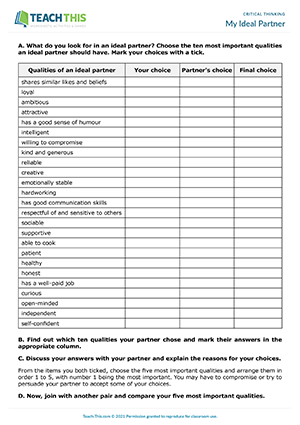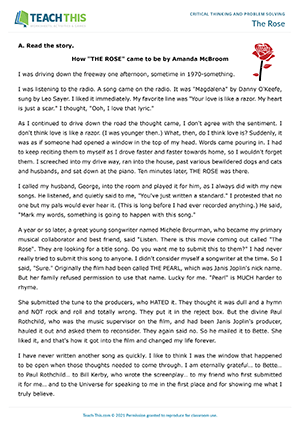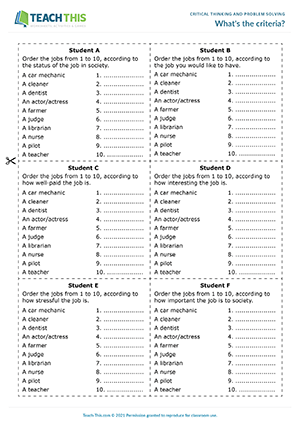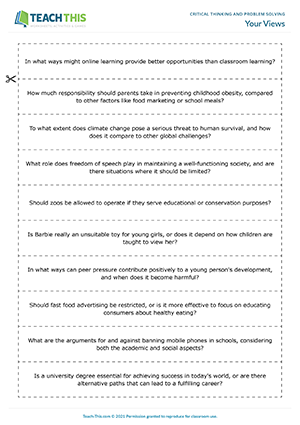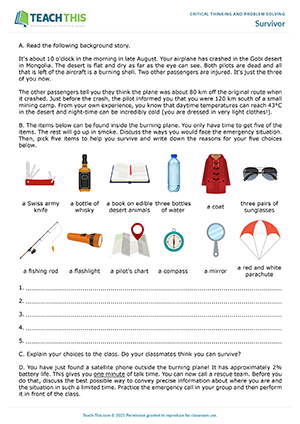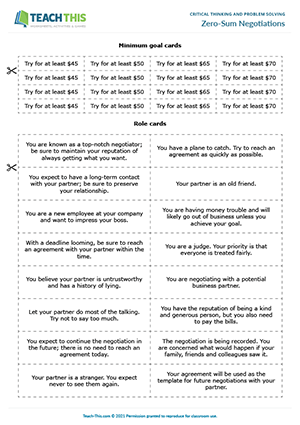Critical Thinking and Problem Solving ESL Activities, Games and Lessons
In this enjoyable critical thinking speaking activity, students consider what makes them happy and share the information with their classmates and examine the findings. Students begin by writing down ten things that make them happy. Students then share the information with a partner and discuss why those things make them happy. Next, each pair joins with another pair. The group discusses the most popular categories for happiness, e.g. money, health, relationships, etc. Students write the most popular categories from their group on the worksheet and examples underneath, e.g. 'If someone says having a well-paid job makes them happy, students put that in the 'money' category'. Each group then reports their findngs to the class who listen and give their opinions on the categories and examples. Finally, write the most popular categories on the board and examine the findings together as a class.
In this free desert island survival game, students use their critical thinking and problem-solving skills to survive being stranded on a desert island. Students imagine that their boat is sinking and that there is a desert island nearby. In groups, students choose four items from the worksheet to help them survive on the island and explain why they chose each one. Next, groups find out what challenge they face on the island by choosing a card. Groups then read the challenge on their card and make a plan on how they are going to survive on the island using the four items to help them. Afterwards, groups take it in turns to read their challenge and present their ideas to the class. Assess each group's chances of survival and score each group between one and three points according to their ideas. After each group has presented, they roll a dice and the awarded points are combined with the number on the dice. Groups need to score four or more to survive. A score of six or more is needed to thrive on the island.
In this engaging critical thinking speaking activity, students prioritize and discuss the most important qualities of an ideal partner. First, students look at a list of adjectives and mark the ten most important qualities of an ideal partner. Next, in pairs, students find out which ten qualities their partner chose and mark their answers on the worksheet. Students then discuss their answers and explain the reasons for their choices. From the items they both ticked, students choose the five most important qualities and arrange them one to five, with number one being the most important. Each pair then joins with another pair and compares their five most important qualities. Finally, there is a class feedback session to find out the most popular qualities for an ideal partner.
This insightful critical thinking speaking activity helps students discuss the topic of stress, its causes, and how to deal with it appropriately. The activity also helps students to use their critical thinking, problem-solving, data collection, analyzing and evaluating skills. First, in pairs, students interview their partner on the top ten most stressful things in their life. Each pair then joins with another pair to compare and discuss their answers and come up with the top five most stressful things for their group. Groups then discuss and write down the cause or causes of each stressful thing. After that, students conduct a class survey on how to reduce stress and relaxation methods using questions from the worksheet, making a note of whether each person they speak to is male or female and how they relax and reduce stress. When the survey is complete, students re-group and read all the data they collected and rank the findings into healthy and unhealthy ways to reduce stress. Finally, each group makes a poster showing the results of the class survey.
This useful critical thinking lesson helps students to think about and discuss the topic of love and understand peoples' different interpretations of what love is. First, students read a short story about how a love song came to be. Students then answer a set of reading comprehension questions based on the story. Next, students listen to a song based on the text and complete a song gap-fill exercise. Afterwards, students discuss the meaning of the song as a class. Finally, students answer discussion questions based on the lesson and talk about their answers in groups.
In this communicative critical thinking and problem-solving activity, students guess what criteria was used to put a list of ten jobs in order. To begin, students order the jobs on their card, according to the given criteria (one being the most important and ten being the least important). In groups, students then use their problem-solving skills to guess what criteria other students used to put their list of ten jobs in order. Students then take it in turns to read out their order from one to ten. The other students in the group analyze the list and discuss the possible criteria. The student with the card listens but cannot help in any way. Students then give their answer. If the students guess correctly, the next student reads out their card. If not, students keep guessing until they get it right. Finally, there is a class feedback session to discuss the job order, according to the criteria.
This free critical thinking speaking activity helps students to use their critical thinking skills to discuss a set of controversial questions. In groups, students read questions and choose three to discuss. Students then have five minutes to discuss each question and come up with an answer, noting down the reasons for their answer and any considerations they made. When all three questions have been discussed, each group chooses a spokesperson to present the group's ideas to the class who respond with their views.
In this communicative problem-solving activity, students use their critical thinking and problem-solving skills in order to survive an imaginary emergency. To start, students read a background story about a plane crash. In groups, students then discuss the ways they would face the emergency situation in the story and pick five items to help them survive, writing down the reasons for their five choices, e.g. a mirror for signalling rescuers by day. Groups then take it in turns to explain their choices to the class who give feedback on their ideas. The class then votes to see if they think the group could survive using the items or not. Next, there is a class discussion about the students' solutions and the class comes up with a list of the five best survival items from the worksheet. Afterwards, groups practice conveying important information in an SOS emergency call in the most effective way possible. The students' task is to call a rescue team and explain where they are and the situation in one minute. Students practice the emergency call first in their groups and then perform it in front of the class.
In this productive critical thinking speaking activity, students practice and reflect on zero-sum negotiations. Students imagine they have been given $100 that they must divide with their partner. However, each student must try to get at least the amount on their minimum goal card. This is a zero-sum negotiation. Students use any negotiation tactic they like and make up a story as to why they need the money. Each pair then has five minutes to negotiate and reach an agreement with their partner for a share of the money with each student using their own story or tactic. When the five minutes are up, students show their partner their goal card. Students then share their goals and the results of their negotiation with the class. Next, students change partners and repeat the five-minute negotiations as before using the instructions on a new card to influence how the negotiation goes. After an agreement has been reached, students reveal their role and goal card to their partner. Lastly, students answer discussion questions, reflecting on their experiences and discuss their answers.





